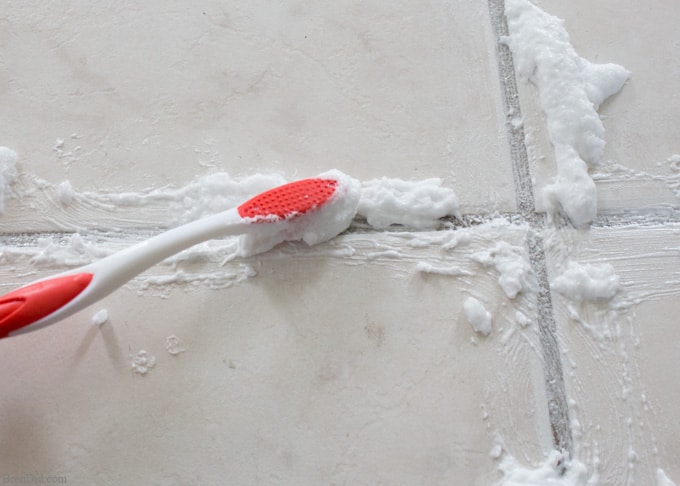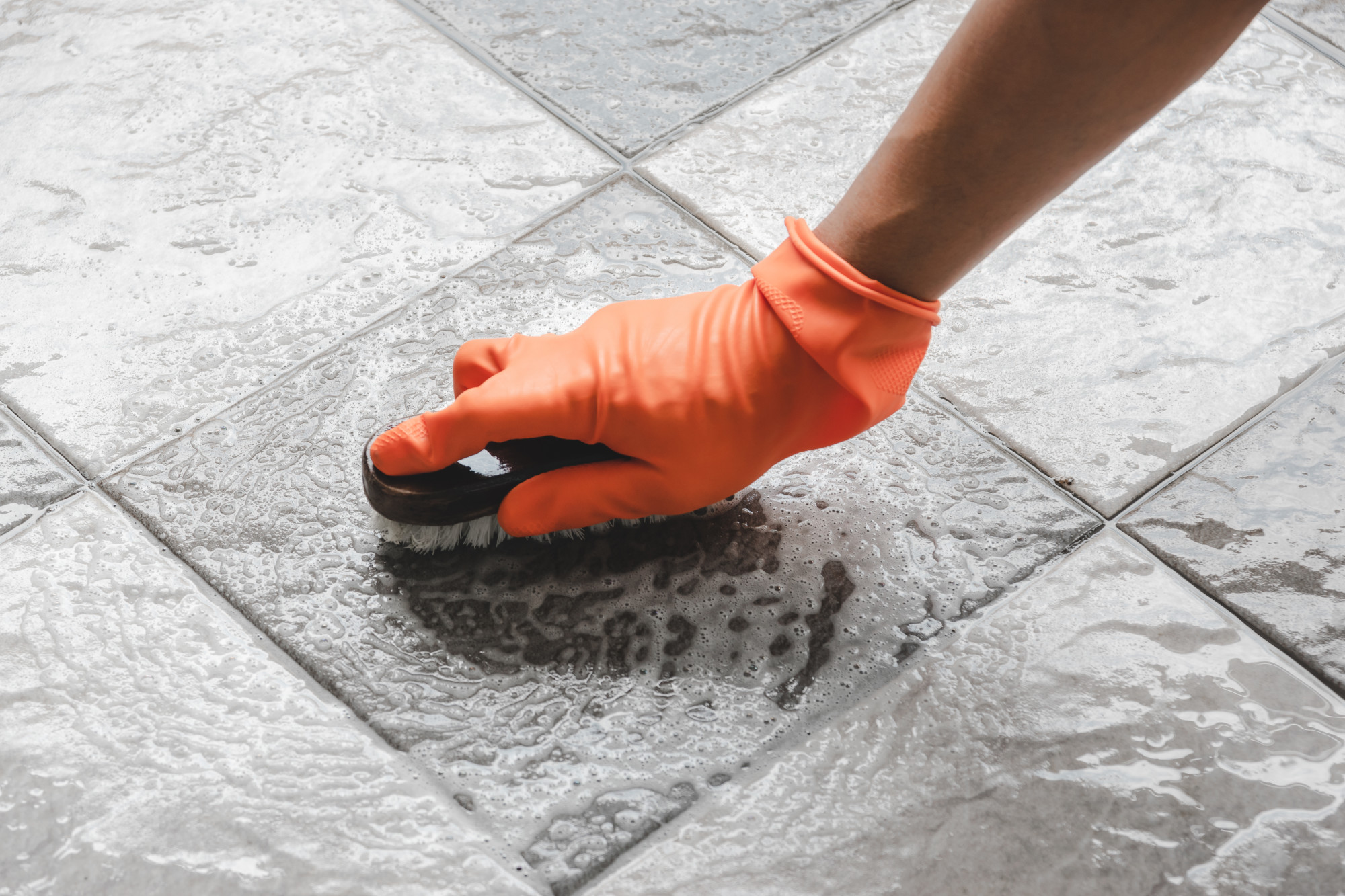Have you ever gazed down at your once pristine tile floors and felt a pang of disappointment at the sight of dingy, discolored grout? That beautiful, uniform tile work can be easily marred by dirt, grime, and even mold that stubbornly cling to the grout lines. But fret not, dear reader! This comprehensive guide will equip you with the knowledge and techniques to conquer even the most stubborn grout stains and restore your tile floors to their former glory.

Image: dragon-upd.com
Cleaning grout effectively is essential for maintaining a clean and healthy home environment. It can also significantly enhance the appearance of your tile floors, making them look brand new. Whether you’re dealing with everyday dirt or tackling tough stains, this guide will provide you with everything you need to know to achieve that sparkling, clean grout that you’ve always desired. So, let’s dive into the world of grout cleaning and discover the secrets to banish those unsightly blemishes!
Understanding the Grout
Before we delve into the cleaning techniques, it’s crucial to understand what grout is and why it’s so prone to staining. Grout is a mortar-like mixture used to fill the gaps between tiles, providing structural support and creating a finished look. While grout adds beauty and functionality to your tile floors, its porous nature makes it susceptible to absorbing dirt, moisture, and other substances, leading to discoloration and staining.
Grout is typically composed of cement, sand, and water, with various additives that influence its color, durability, and resistance to staining. Common grout colors include white, gray, beige, and even black. However, over time, the color of grout can change as it becomes stained with dirt, food spills, or even the natural oils from your skin.
The Importance of Regular Cleaning
Regular cleaning is paramount for maintaining the appearance and health of your tile floors. When you neglect cleaning your grout, it can become a breeding ground for bacteria, mold, and mildew. These microorganisms thrive in damp, dark environments and can contribute to unpleasant odors, allergies, and even respiratory issues. Furthermore, neglecting regular cleaning can lead to deep-set stains that are difficult to remove.
The frequency of your cleaning routine depends on the level of foot traffic in your home, the type of tile, and the surrounding environment. High-traffic areas, such as kitchens and bathrooms, may require more frequent cleaning than bedrooms or living rooms. A good rule of thumb is to sweep or vacuum your tile floors regularly and mop them at least once a week, using a mild detergent or specialized grout cleaner.
Essential Tools and Materials
Now that you understand the importance of regular cleaning let’s equip ourselves with the tools and materials necessary for the task. Here’s a comprehensive list of essential items:
- Grout Brush: A grout brush is specifically designed for cleaning the narrow crevices of grout lines. Choose a brush with stiff bristles and a comfortable handle for easy maneuvering.
- Cleaning Solution: There are various cleaning solutions available for grout, ranging from commercially available cleaners to homemade mixtures. We’ll explore these options in detail later in the article.
- Bucket: A large bucket will be needed to hold your cleaning solution and provide space for rinsing the grout brush.
- Microfiber Cloth: Microfiber cloths are excellent for wiping away dirt, cleaning solution, and excess moisture. They are also highly absorbent and lint-free, minimizing streaks.
- Gloves: Protecting your hands is important, especially when dealing with harsh cleaning chemicals. Wear rubber or latex gloves to prevent skin irritation.
- Safety Goggles: For added protection and to prevent any cleaning solution from splashing into your eyes, wear safety goggles throughout the cleaning process.
- Old Toothbrush: An old toothbrush can be useful for reaching tight spaces and getting into intricate corners of your grout lines.

Image: bluejaycarpetcleaning.com
DIY Grout Cleaning Solutions
Before jumping into commercially available grout cleaners, let’s explore some effective and cost-efficient DIY solutions:
1. Baking Soda and Water Paste:
Combining baking soda with water creates a gentle abrasive paste that can effectively remove dirt and grime from grout. Simply mix equal parts baking soda and water to form a thick paste. Apply the paste to your grout lines using an old toothbrush, scrub gently, and then wipe away with a damp cloth.
2. White Vinegar and Water Solution:
The acidity of white vinegar helps to break down stubborn stains and grime. Mix equal parts white vinegar and water in a spray bottle. Spray the solution onto your grout lines, allow it to sit for a few minutes, then scrub with a grout brush. Rinse with clean water and wipe dry.
3. Hydrogen Peroxide and Baking Soda Paste:
This potent combination can effectively bleach grout and remove stubborn stains. Mix equal parts hydrogen peroxide and baking soda to form a paste. Apply the paste to your grout lines, allow it to sit for 15-20 minutes, and then scrub with a grout brush. Rinse with clean water and wipe dry. Be mindful of this mixture’s bleaching properties and test it on an inconspicuous area first.
Commercially Available Grout Cleaners
For more challenging stains or for those who prefer a ready-made solution, various commercially available grout cleaners can be purchased at your local hardware store or online. These cleaners typically contain powerful ingredients that can effectively remove dirt, grease, and mold from grout.
When choosing a commercial grout cleaner, carefully read the label and select a product suitable for your specific type of grout and tile. Some cleaners are specifically formulated for natural stone and may not be appropriate for ceramic or porcelain tiles. Always follow the instructions on the product label, wear protective gear, and ensure adequate ventilation while using these cleaners.
Advanced Grout Cleaning Techniques
For stubborn stains and heavy discoloration, you may require more intensive cleaning techniques. These techniques involve using more powerful tools and solutions, so proceed with caution and always prioritize safety.
1. Power Grout Cleaning:
Power grout cleaners use a high-pressure stream of water to dislodge dirt and grime from grout lines. These machines are typically available for rent at hardware stores or home improvement centers. Before using a power grout cleaner, carefully read the instructions and follow safety precautions. Ensure adequate ventilation and wear protective gear.
2. Grout Sealer:
After you have thoroughly cleaned your grout, applying a grout sealer can help to protect it from future stains and discoloration. Sealant forms a barrier on the surface of the grout, preventing dirt and moisture from penetrating. Select a sealant specifically designed for your type of grout and follow the manufacturer’s instructions for application.
Maintaining Sparkling Grout
Once you’ve achieved that glistening, clean grout, it’s essential to maintain that look. Here are some tips to help you keep your grout sparkling clean:
- Regular Cleaning: Sweep or vacuum your tile floors frequently to remove loose dirt and debris. This will prevent grime from building up on your grout.
- Quick Clean-Ups: Address spills and messes immediately. The longer dirt, grease, or stains sit on your grout, the more difficult they will be to remove.
- Deep Cleaning: Deep clean your grout at least once a month or more often in high-traffic areas. This regular cleaning will prevent stubborn stains from accumulating and keep your grout looking its best.
- Avoid Harsh Chemicals: While strong cleaning agents may seem tempting, they can damage your grout and tile over time. Use mild detergents or grout cleaning solutions designed for your specific tile type.
- Use Grout Sealer: Regularly applying a grout sealer can significantly contribute to the long-term maintenance of your grout. This protective layer will help to repel dirt and moisture, keeping your grout looking brighter for longer.
Best Way To Clean Floor Tile Grout
Conclusion
Taming those stubborn grout stains and restoring your tile floors to their pristine glory is within your reach. By understanding the nature of grout, employing the right cleaning techniques, and maintaining a regular cleaning schedule, you can achieve that sparkling, clean grout that will enhance the beauty of your home. Now go forth, armed with this knowledge, and conquer those unsightly grout lines! And remember, if you have any questions or want to explore alternative cleaning solutions, don’t hesitate to consult a professional cleaning service or a tile specialist.





